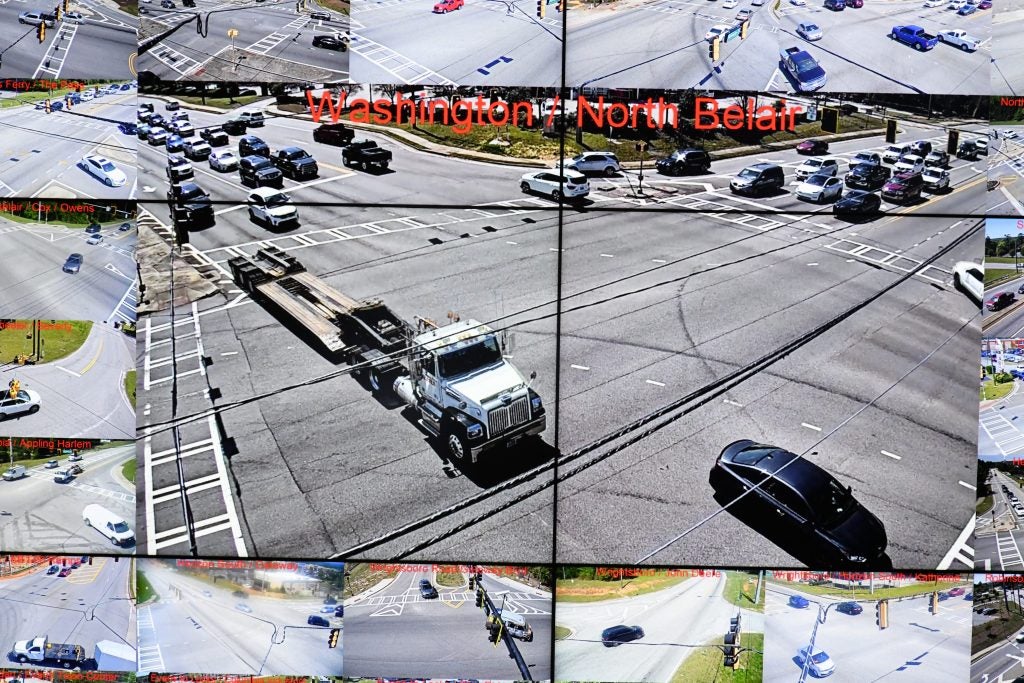If you drive in Columbia County, a computer decides when you get a red or green light. And it’s likely saving you time and money.
Columbia County was the first in Georgia to install an innovative network that links all of the suburban county’s 78 intersections with traffic lights to a county command center in Evans. Inside Columbia County’s Traffic Control Center, a software program that uses cameras and a sophisticated algorithm decides when you wait and when you go.
MORE: Local animator produces video that is ‘out of this world’
It’s not cheap. Taxpayers spend about $50,000 per intersection to put in the camera gear and network equipment. But a study found the smart system saves Columbia County drivers 29% of their time, reduces stops at lights by 71% and saves you about 15% on your gasoline bill. In all, drivers in Columbia County save an estimated $2.9 million a year because of the In/Sync system, according to a joint study the county conducted with Rhythm Engineering, the company that makes the traffic light network and Artificial Intelligence (AI) software.

“It’s helping us so much in the morning and afternoons,” said Randy Prickett, the county’s traffic engineering and operations manager.
Most traffic lights work on a fixed timer. Traffic engineers can tinker with the timers based on morning or afternoon commuter patterns, but they had to do that at each traffic light. If the traffic pattern changed, the traffic light timing wouldn’t change until a traffic department employee came out and changed the settings on each light, Prickett said.
But with the In/Sync program Tony Williams, a traffic engineering supervisor, can monitor a bank of computers and a wall of monitors showing dozens of intersections. Most of the time the software makes adjustments, but sometimes Williams intervenes to help ease congestion. A few taps on his keyboard and the changes are done. He doesn’t even have to get up from his chair to do it.
The coordinated lights can save lives in two ways as well.

The Columbia County Sheriff’s Office has access and master control of the traffic cameras. When a deputy makes a stop, as one was doing during a reporter’s recent visit, a dispatcher adjusts the camera to zoom in on the deputy and the stopped driver. If the driver grabs a gun, the dispatcher can warn the deputy over the radio.
Investigators can search through old videos to look for suspects’ vehicles as well.
Last week, county commissioners agreed to spend $23,500 per year to buy an additional software program that will search the traffic camera videos based on typed-in search queries.
“For example, if we had a child in a red shirt missing from a park, the software would look for a child in a red shirt from all our cameras in a matter of minutes,” said Scott Johnson, the Columbia County manager.
MORE: Column: The unexpected joys of publishing a memoir
Doug Duncan, the chairman of the commission, said in one year he wants a report detailing whether the new subscription is worth the costs.
The other way the In/Sync system can save lives is by reducing backed up traffic on Interstate-20. During the afternoon, commuters returning to Grovetown back up from Lewiston Road onto I-20.
“Getting hit in the rear end when someone is going 75 miles per hour and you’re stopped – it’s going to be a bad day,” Prickett said.
But clearing the traffic off the highway means two or three lights down the road those waiting to cross Lewiston Road have to wait longer than usual. They probably don’t even consider the extra 30 seconds may actually save another driver’s life.
Joshua B. Good is a staff reporter covering Columbia County and military/veterans’ issues for The Augusta Press. Reach him at joshua@theaugustapress.com











